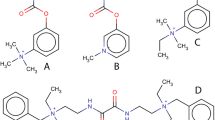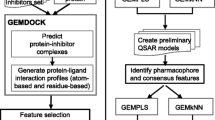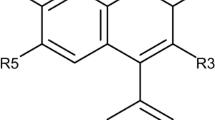Abstract
The Monte Carlo method was used for QSAR modeling of dimeric pyridinium compounds as acetylcholine esterase inhibitors. QSAR model was developed for a series of 39 dimeric pyridinium compounds. QSAR models were calculated with the representation of the molecular structure by the simplified molecular-input line-entry system. One split into the training and test set have been examined. The statistical quality of the developed model is very good. The calculated model for dimeric pyridinium derivatives had following statistical parameters: r 2 = 0.9477 for the training set and r 2 = 0.9332 the test set. Structural indicators considered as molecular fragments responsible for the increase and decrease in the inhibition activity have been defined. The computer-aided design of new dimeric pyridinium compounds potential acetylcholine esterase inhibitors with the application of defined structural alerts has been presented.





Similar content being viewed by others
References
Giacobini E (2008) Cholinesterase inhibitors: new roles and therapeutic alternatives. Pharmacol Res 50:433–440
Millard CB, Broomfield CA (1995) Anticholinesterases: medical applications of neurochemical principles. J Neurochem 64:1909–1918
Bevan DR, Donati F, Kopman AF (1992) Reversal of neuromuscular blockade. Anesthesiology 77:785–805
Drachman DB (1994) Myasthenia gravis. N Engl J Med 330:1797–1810
Richman DP, Agius MA (2003) Treatment of autoimmune myasthenia gravis. Neurology 61:1652–1661
Lindstrom JM (2000) Acetylcholine receptors and myasthenia. Muscle Nerve 23:453–477
Vincent A, Palace J, Hilton-Jones D (2001) Myasthenia gravis. Lancet 357:2122–2128
Conti-Fine BM, Milani M, Kaminski HJ (2006) Myasthenia gravis: past, present, and future. J Clin Invest 116:2843–2854
Rubin DI, Hentschel K (2007) Is exercise necessary with repetitive nerve stimulation in evaluating patients with suspected myasthenia gravis? Muscle Nerve 35:103–106
Lucia A, Maté-Muñoz JL, Pérez M, Foster C, Gutiérrez-Rivas E, Arenas J (2007) Double trouble (McArdle’s disease and myasthenia gravis): How can exercise help? Muscle Nerve 35:125–128
Leigh P, Abrahams S, Al-Chalabi A, Ampong M, Goldstein L, Johnson J, Lyall R, Moxham J, Mustfa N, Rio A, Shaw C, Willey E (2003) The management of motor neurone disease. J Neurol Neurosurg Psychiatry 74(Suppl 4):iv32–iv47
Juel VC, Massey JM (2005) Autoimmune Myasthenia Gravis: recommendations for treatment and immunologic modulation. Curr Treat Options Neurol 7:3–14
Froelich J, Eagle CJ (1996) Anaesthetic management of a patient with myasthenia gravis and tracheal stenosis. Can J Anaesth 43:84–89
Juel VC, Massey JM (2007) Myasthenia gravis. Orphanet J Rare Dis 2:44
Hansch C, Hoekman D, Gao H (1996) Comparative QSAR: toward a deeper understanding of chemicobiological interactions. Chem Rev 96:1045–1076
Cherkasov A, Muratov EN, Fourches D, Varnek A, Baskin II, Cronin M, Dearden J, Gramatica P, Martin YC, Todeschini R, Consonni V, Kuz’Min VE, Cramer R, Benigni R, Yang C, Rathman J, Terfloth L, Gasteiger J, Richard A, Tropsha A (2014) QSAR modeling: Where have you been? Where are you going to? J Med Chem 57:4977–5010
Tropsha A, Golbraikh A (2007) Predictive QSAR modeling workflow, model applicability domains, and virtual screening. Curr Pharm Des 13:3494–3504
Cronin MTD, Schultz TW (2003) Pitfalls in QSAR. J Mol Struct-THEOCHEM 622:39–51
Duchowicz PR, Comelli NC, Ortiz EV, Castro EA (2012) QSAR study for carcinogenicity in a large set of organic compounds. Curr Drug Saf 7:282–288
Talevi A, Bellera CL, Ianni MD, Duchowicz PR, Bruno-Blanch LE, Castro EA (2012) An integrated drug development approach applying topological descriptors. Curr Comput Aided Drug Des 8:172–181
Randic M, Basak SC (2010) New descriptor for structure-property and structure-activity correlations. J Chem Inf Comput Sci 41:650–656
da Silva Junkes B, Arruda ACS, Yunes RA, Porto LC, Heinzen VEF (2005) Semi-empirical topological index: a tool for QSPR/QSAR studies. J Mol Model 11:128–134
Ivanciuc O (2013) Chemical graphs, molecular matrices and topological indices in chemoinformatics and quantitative structure–activity relationships. Curr Comput Aided Drug Des 9:153–163
Weininger D (1988) SMILES, a chemical language and information system. 1. Introduction to methodology and encoding rules. J Chem Inf Comput Sci 28:31–36
Weininger D, Weininger A, Weininger JL (1989) SMILES. 2. Algorithm for generation of unique SMILES notation. J Chem Inf Comput Sci 29:97–101
Weininger D (1990) SMILES. 3. Depict. Graphical depiction of chemical structures. J Chem Inf Comput Sci 30:237–243
Toropov AA, Benfenati E (2007) SMILES in QSPR/QSAR modeling: results and perspectives. Curr Drug Discov Technol 4:77–116
Toropov AA, Benfenati E (2007) SMILES as an alternative to the graph in QSAR modelling of bee toxicity. Comput Biol Chem 31:57–60
Veselinović AM, Veselinović JB, Živković JV, Nikolić GM (2015) Application of SMILES notation based optimal descriptors in drug discovery and design. Curr Top Med Chem 15:1768–1779
Conejo-García A, Pisani L, Del Carmen Núñez M, Catto M, Nicolotti O, Leonetti F, Campos JM, Gallo MA, Espinosa A, Carotti A (2011) Homodimeric bis-quaternary heterocyclic ammonium salts as potent acetyl- and butyrylcholinesterase inhibitors: a systematic investigation of the influence of linker and cationic heads over affinity and selectivity. J Med Chem 54:2627–2645
Ojha PK, Roy K (2011) Comparative QSARs for antimalarial endochins: importance of descriptor-thinning and noise reduction prior to feature selection. Chemometr Intell Lab Syst 109:146–161
Toropova AP, Toropov AA, Benfenati E, Gini G, Leszczynska D, Leszczynski J (2011) CORAL: quantitative structure-activity relationship models for estimating toxicity of organic compounds in rats. J Comput Chem 32:2727–2733
Toropov AA, Toropova AP, Puzyn T, Benfenati E, Gini G, Leszczynska D, Leszczynski J (2013) QSAR as a random event: modeling of nanoparticles uptake in PaCa2 cancer cells. Chemosphere 92:31–37
Roy K (2007) On some aspects of validation of predictive quantitative structure activity relationship models. Expert Opin Drug Dis 2:1567–1577
Roy PP, Leonard JT, Roy K (2008) Exploring the impact of the size of training sets for the development of predictive QSAR models. Chemometr Intell Lab Syst 90:31–42
Gramatica P (2007) Principles of QSAR models validation: internal and external. QSAR Comb Sci 26:694–701
Toropov AA, Toropova AP, Lombardo A, Roncaglioni A, Benfenati E, Gini G (2011) CORAL: building up the model for bioconcentration factor and defining it’s applicability domain. Eur J Med Chem 46:1400–1403
Roy K, Mitra I, Kar S, Ojha PK, Das RN, Kabir H (2012) Comparative studies on some metrics for external validation of QSPR models. J Chem Inf Model 52:396–408
Ojha PK, Mitra I, Das R, Roy K (2011) Further exploring rm2 metrics for validation of QSPR models. Chemometr Intell Lab Syst 107:194–205
Ojha PK, Roy K (2011) Comparative QSARs for antimalarial endochins: importance of descriptor-thinning and noise reduction prior to feature selection. Chemometr Intell Lab 109:146–161
Toropova AP, Toropov AA, Veselinović JB, Miljković FN, Veselinović AM (2014) QSAR models for HEPT derivates as NNRTI inhibitors based on Monte Carlo method. Eur J Med Chem 77:298–305
Veselinović AM, Milosavljević JB, Toropov AA, Nikolić GM (2013) SMILES-based QSAR model for arylpiperazines as high-affinity 5-HT1A receptor ligands using CORAL. Eur J Pharm Sci 48:532–541
Acknowledgments
We would like to thank reviewers whose suggestions have improved our manuscript. This work has been supported by the Ministry of Education and Science, the Republic of Serbia, under Project Number 43012.
Author information
Authors and Affiliations
Corresponding author
Ethics declarations
Conflict of interest
All authors declare that they have no conflict of interest.
Electronic supplementary material
Below is the link to the electronic supplementary material.
Rights and permissions
About this article
Cite this article
Sokolović, D., Stanković, V., Toskić, D. et al. Monte Carlo-based QSAR modeling of dimeric pyridinium compounds and drug design of new potent acetylcholine esterase inhibitors for potential therapy of myasthenia gravis . Struct Chem 27, 1511–1519 (2016). https://doi.org/10.1007/s11224-016-0776-z
Received:
Accepted:
Published:
Issue Date:
DOI: https://doi.org/10.1007/s11224-016-0776-z




